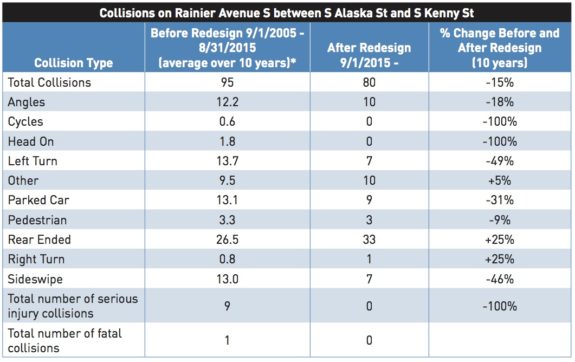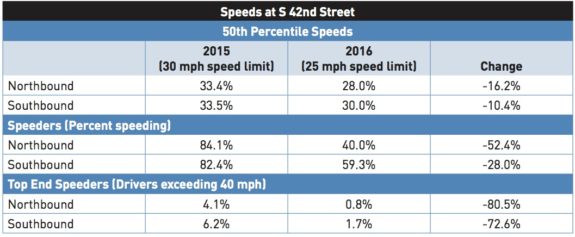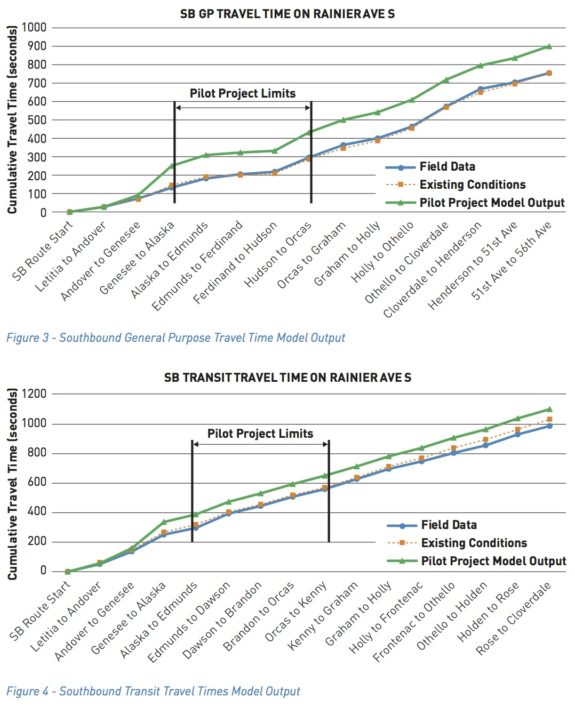Rainier Ave safety project worked even better than planned, city will extend it south
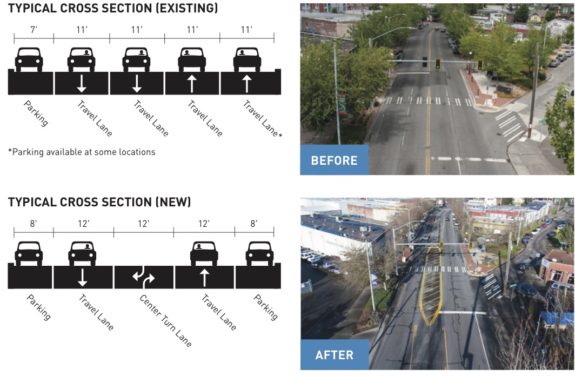
Images from SDOT's before and after report.
A 2015 safe streets redesign on Rainier Ave is working even better than expected by nearly every measure.
Just by repainting the lines on the major street, the city's Vision Zero team was able to dramatically reduce the number of dangerous collisions, nearly eliminate high-end speeding, speed up transit, and fully eliminate serious injuries and deaths. Meanwhile, delays for people driving were minimal, clocking in well below pre-construction estimates, according to a new report (PDF).
In other words, Rainier Ave now works better for everyone.
The new report comes out as SDOT starts public outreach for an extension of the safety project from the current project boundary south of Hillman City all the way to Rainier Beach, where safety improvements were completed in recent years. When the new project is complete, Rainier Ave will be significantly calmed from Columbia City to the southend city limits.
Details on an upcoming meeting and a project online survey from SDOT:
We want to hear about your experiences traveling on Rainier Ave S. This will help inform Phase 2 of the project and let us know how Phase 1 is working.
Click here to take our survey.
Or come talk to us in person at this upcoming event! We'll share Phase 1 results and talk about extending changes from S Kenny St to S Henderson St.
- March 7: We a Southeast Seattle:Investing in Rainier Ave S Community Forum
- Emerald City Bible Fellowship, 7728 Rainier Ave S, Seattle, WA
- 5:30 PM-7:30 PM
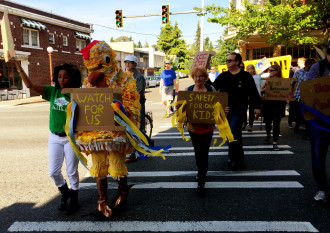
Phyllis Porter of Rainier Valley Greenways leads safe street chants as community members walk in the crosswalks holding signs calling for a safer Rainier.
The safety project happened after a lot of community pressure, including a protest in Columbia City decrying the outsized danger of the Rainer Valley's most important street.
In the ten years prior to the changes, 11 people were killed and 1,700 people were seriously injured on the four miles of Rainier Ave south of Mount Baker. That's a neighbor, co-worker or loved one seriously injured every two days just on this one street. The collision rate was much higher than even Aurora or Lake City Way, which are also among the city's most dangerous street.
The protestors made the point clearly: Without city action to improve safety, this immense amount of pain and suffering would not end.
As the data shows, they were right. After safety changes went into place, collisions declined. But most importantly, the most dangerous kinds of collisions (head-on, left turn) went way down, offset by small increases in less dangerous fender-benders:
Serious injuries and deaths were eliminated.
To put that another way, more than a dozen people are living their daily lives right now completely oblivious to the fact that without this safety project, they would be suffering potentially debilitating, lifelong injuries. One of those dozen people could be your best friend. Or your mother. And at least one person's life was spared.
These are very powerful public health outcomes. We have a moral obligation to extend and repeat this success.
Much of the reduction in serious injuries and deaths is due to a safer street design that makes turning movements and crosswalks safer and easier. But another major element is due to a major decrease in speeding. Speeding decreased significantly, but top-end speeding (people going 40 mph or faster) went down by an astounding 73 to 81 percent. Only 1 - 2 percent of people driving on Rainier today are going faster than 40 mph.
But a major reduction in speeding did not translate into significant increases in travel times, which I understand seems counterintuitive. But changes to signal timing and adding a center turn lane has made the street much more efficient.
Four-lane streets are designed to operate like rural highways with relatively few turning movements. But the Rainier Valley is not farmland. It's a destination-packed corridor through the heart of many business districts and neighborhoods. That means many people are trying to make turns, and every time someone puts their blinker on and comes to a stop, traffic behind them slows or stops. Often people make dangerous lane changes to get around the person waiting to turn. It's dangerous, and it doesn't work.
A center turn lane allows each direction to continue moving, which increases the efficiency of the street while also using less space. In the Rainier pilot project, that extra space was used to add on-street parking, but it could also be used for bike lanes.
The result is that driving times increased by just a single minute despite big decreases in speeding. For all the immense benefits we've discussed, that's an insignificant trade-off.
Vitally, transit travel times improved by three minutes northbound and stayed the same southbound. Keeping Metro's very busy Route 7 bus on schedule was a major goal of the project, and planners did even better.
Traffic volumes on Rainier Ave decreased as more people took MLK Jr Way instead. Traffic on Lake Washington Blvd and Seward Park Avenue also dropped slightly after the changes went into place, which is good news for neighbors who were concerned about increases in side street traffic. That didn't happen, according to the report.
So even though the project extension is already a year behind schedule, it's great news that the city is moving forward. There's essentially no reason to stop the project now. The question is: Can it be even better?
